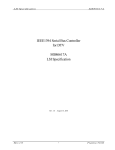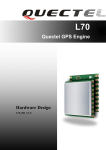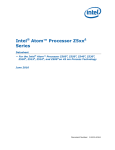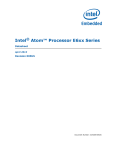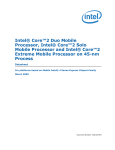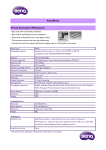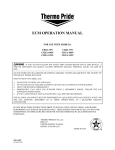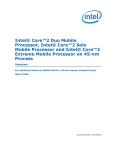Download Intel Atom Z670
Transcript
Intel® Atom™ Processor Z6xx Series Datasheet For the Intel® Atom™ Processor Z670 on 45-nm Process Technology April 2011 Revision 001 Document Number: 325310-001 INFORMATION IN THIS DOCUMENT IS PROVIDED IN CONNECTION WITH INTEL® PRODUCTS. NO LICENSE, EXPRESS OR IMPLIED, BY ESTOPPEL OR OTHERWISE, TO ANY INTELLECTUAL PROPERTY RIGHTS IS GRANTED BY THIS DOCUMENT. EXCEPT AS PROVIDED IN INTEL'S TERMS AND CONDITIONS OF SALE FOR SUCH PRODUCTS, INTEL ASSUMES NO LIABILITY WHATSOEVER, AND INTEL DISCLAIMS ANY EXPRESS OR IMPLIED WARRANTY, RELATING TO SALE AND/OR USE OF INTEL PRODUCTS INCLUDING LIABILITY OR WARRANTIES RELATING TO FITNESS FOR A PARTICULAR PURPOSE, MERCHANTABILITY, OR INFRINGEMENT OF ANY PATENT, COPYRIGHT OR OTHER INTELLECTUAL PROPERTY RIGHT. UNLESS OTHERWISE AGREED IN WRITING BY INTEL, THE INTEL PRODUCTS ARE NOT DESIGNED NOR INTENDED FOR ANY APPLICATION IN WHICH THE FAILURE OF THE INTEL PRODUCT COULD CREATE A SITUATION WHERE PERSONAL INJURY OR DEATH MAY OCCUR. Intel may make changes to specifications and product descriptions at any time, without notice. Designers must not rely on the absence or characteristics of any features or instructions marked "reserved" or "undefined." Intel reserves these for future definition and shall have no responsibility whatsoever for conflicts or incompatibilities arising from future changes to them. The information here is subject to change without notice. Do not finalize a design with this information. The Intel® Atom™ Processor Z670 component may contain design defects or errors known as errata which may cause the product to deviate from published specifications. Current characterized errata are available on request. For Enhanced Intel SpeedStep® Technology : See the Processor Spec Finder at http://ark.intel.com or contact your Intel representative for more information Intel, Intel Atom and the Intel logo are trademarks of Intel Corporation in the U. S. and other countries. *Other names and brands may be claimed as the property of others. Copyright © 2011 Intel Corporation. All rights reserved. 2 Datasheet Contents 1 Introduction ................................................................................................... 6 1.1 1.2 1.3 1.4 2 Display Controller .......................................................................7 1.2.3 cDMI .........................................................................................7 1.2.4 cDVO ........................................................................................8 1.2.5 LVDS ........................................................................................8 Terminology ............................................................................................8 Reference Documents...............................................................................9 Signal Description .................................................................................. 11 2.1.1 System Memory Interface .......................................................... 11 2.1.2 cDMI Interface ......................................................................... 13 2.1.3 cDVO Interface ......................................................................... 13 2.1.4 LVDS Display Port Interface ....................................................... 14 2.1.5 LGI/LGIe (Legacy) Signals ......................................................... 15 2.1.6 Debug and Miscellaneous Signals................................................ 16 2.1.7 Power Signals .......................................................................... 17 Power Management ...................................................................................... 18 3.1 4 1.2.2 Signal Descriptions ....................................................................................... 11 2.1 3 Processor Features ...................................................................................6 Interfaces ...............................................................................................7 1.2.1 System Memory Support .............................................................7 Processor Core Low Power Features ......................................................... 18 3.1.1 Cx State Definitions .................................................................. 20 Electrical Specifications ................................................................................ 22 4.1 4.2 4.3 4.4 Power and Ground Balls .......................................................................... 22 Decoupling Guidelines ............................................................................ 22 Voltage Rail Decoupling .......................................................................... 22 Voltage Identification (VID) ..................................................................... 23 4.4.1 VID Enable .............................................................................. 23 4.4.2 4.5 4.6 5 Absolute Maximum Ratings ..................................................................... 25 DC Specifications ................................................................................... 26 Thermal Specifications and Design Considerations ....................................... 31 5.1 5.2 Datasheet VID Table ................................................................................ 24 Temperature Monitoring ......................................................................... 32 Intel® Thermal Monitor ........................................................................... 32 5.2.1 Digital Thermal Sensor .............................................................. 34 5.2.2 Out of Specification Detection .................................................... 35 5.2.3 Catastrophic Thermal Protection ................................................. 35 5.2.4 PROCHOT# Signal Pin ............................................................... 35 3 6 Package Mechanical Specifications and Pin Information ............................... 37 6.1 6.2 Package Mechanical Specifications ........................................................... 37 Processor Pinout Assignment ................................................................... 39 Figures Figure 3-1. Thread Low Power States .................................................................. 19 Figure 3-2. Package Low Power States ................................................................ 19 Figure 6-1. Package Mechanical Drawing ............................................................. 38 Tables Table 2-1. Signal Types ..................................................................................... 11 Table 2-2. Buffer Types ..................................................................................... 11 Table 2-3. System Memory Interface Signals ....................................................... 11 Table 2-4. cDMI Interface Signal ........................................................................ 13 Table 2-5. cDVO Interface Signals ...................................................................... 13 Table 2-6. LVDS Display Port Interface Signals ..................................................... 14 Table 2-7. LGI/LGIe Legacy Signals .................................................................... 15 Table 2-8. Debug and Miscellaneous Signals ........................................................ 16 Table 2-9. Power Signals ................................................................................... 17 Table 4-1. VIDEN Encoding ................................................................................ 23 Table 4-2. VID Table ......................................................................................... 24 Table 4-3. Absolute Maximum Ratings ................................................................. 25 Table 4-4. Voltage and Current Specifications ...................................................... 26 Table 4-5. Differential Clock DC Specifications ...................................................... 28 Table 4-6. AGTL+, CMOS, and CMOS Open Drain Signal Group DC Specifications ..... 28 Table 4-7. CMOS1.8 Signal Group DC Specifications.............................................. 29 Table 4-8. LVDS Signal Group DC Specifications ................................................... 29 Table 5-1. Thermal Design Power Specifications ................................................... 31 Table 5-2. Support for PROCHOT#/THERMTRIP# in Active and Idle States ............... 34 Table 6-1. Processor Pinout (Top View—Columns 21–31) ....................................... 40 Table 6-2. Processor Pinout (Top View—Columns 11–20) ....................................... 41 Table 6-3. Processor Pinout (Top View—Columns 1–10) ........................................ 42 Table 6-4. Pinout—Ordered by Signal Name ......................................................... 43 4 Datasheet Revision History Document Number Revision Number 325314 001 Description Revision Date April 2011 • Initial release. § Datasheet 5 Introduction 1 Introduction The datasheet describes the architecture, features, buffers, signal descriptions, power management, pin states, operating parameters, and specifications for the Intel® Atom™ Processor Z670 (Core Processor and North Complex). Intel® Atom™ Processor Z670 is the next generation low power IA-32 processor that is based on the new re-partitioning architecture targeted for tablets and sleek netbooks. The main components of Intel® Atom™ Processor Z670 are: an IAcompatible processor core derived from the Intel® Atom™ processor, a single-channel 32-bit DDR2 memory controller, a 3-D graphics engine, video decode engines, a 2-D display controller, a cDMI interface link to the Intel® SM35 Express Chipset, and an LVDS interface to support a primary display interface link. An additional cDVO interface is used for pixel data to the Intel® SM35 Express Chipset. Throughout this document, the Intel® Atom™ Processor Z670 is referred as the processor and Intel® SM35 Express Chipset is referred to as the chipset. 1.1 Processor Features The following list provides some of the key features on this processor: • Supports Intel® Hyper-Threading Technology • 2-wide instruction decode and in-order execution • 512 KB, 8 way L2 cache • Support for IA 32-bit architecture • FCMB3 packaging technology • Thermal management support using TM1 and TM2 • On die Digital Thermal Sensor (DTS) for thermal management support using Intel® Thermal Monitor 1 (TM1) and Intel® Thermal Monitor 2 (TM2) • Advanced power management features including Enhanced Intel® SpeedStep® Technology • Supports C0/C1(e)/C2(e)/C4(e) power states • Intel Deep Power Down Technology (C6) 6 Datasheet Introduction 1.2 Interfaces 1.2.1 System Memory Support 1.2.2 • One channel of DDR2 memory • 32-bit data bus • Memory DDR2 transfer rates of 800 MT/s • Supports 1 Gb, and 2 Gb devices • Supports total memory size of 1 GB, and 2 GB • Provides aggressive power management to reduce power consumption when idle • Provides proactive page closing policies to close unused pages Display Controller • Seven display planes: Display Plane A, Display Plane B, Display C/sprite, Overlay, Cursor A, Cursor B, and VGA • Display Pipe A: Supports LVDS display interface • Display Pipe B: Supports HDMI via chipset • Maximum resolution (LVDS display): 1366 x 768 @ 18 bpp and 60 fps 1.2.3 Datasheet • Supports 18 bpp • Supports Non-Power of 2 Tiling • Output pixel width: 24-bit RGB • Supports NV12 video data format • Supports 3 x 3 panel fitter • Dynamic Power Saving Technology (DPST) 3.0 • Support 16 x 256 byte tile size • Supports overlay • Supports global constant alpha blending cDMI • Peak raw BW of cDMI link per direction = 400 MT/s using a quad-pumped 8-bit transmit and an 8-bit receive data bus • Supports low power management schemes • Supports CMOS interface 7 Introduction 1.2.4 1.2.5 1.3 cDVO • Peak raw BW of 800MT/s • Supports low power management schemes • Supports AGTL+ interface LVDS • Maximum resolution (internal display) of: • 1366 x 768 @ 18 bpp and 60 fps • Dot clock range from 20–83 MHz • Four differential signal pairs: Three data pairs (up to 581 Mbps on each data link) and one clock pair • Supports 18 bpp packed and 18 bpp loosely packed pixel formats • Supports 24 bpp with a limited number of validated panels. Terminology Acronym 8 Description ACPI Advanced Configuration and Power Interface AGTL+ Assisted Gunning Transceiver Logic Plus CKE Clock enable CMOS Complementary metal-oxide semiconductor cDMI CMOS Direct Media Interface cDVO CMOS Digital Video Output DDR2 Second-generation Double Data Rate SDRAM memory technology DQ Memory data DQS Memory data strobe DTS Digital thermal sensor FSB Front side bus GPIO General purpose input/output GTL Gunning Transceiver Logic HPLL Host phase lock loop IERR Internal error iFSB Internal front side bus LFM Low Frequency Mode LGI Legacy interface Datasheet Introduction Acronym 1.4 Description LVDS Low Voltage Differential Signaling, a high speed, low power data transmission standard used for display connections to LCD panels MSR Model-specific register NCTF Non-Critical to Function. NCTF locations are typically redundant ground or non-critical reserved, so the loss of solder joint continuity at end of life conditions will not affect the overall product functionality. NMI Non-maskable interrupt North Complex Processor unicore which processor memory controller, Power Management Unit and internal FSB Logic ODT On Die Termination PCH Platform Controller Hub PMIC Power Management Integrated Circuit PMU Power Management Unit RCOMP Resistor compensation SCK System clock SR Self-Refresh TAP Test access point TCC Thermal control circuit TDP Thermal Design Power TM1 Thermal Monitor 1 TM2 Thermal Monitor 2 VR Voltage regulator Reference Documents Document Intel® Atom™ Processor Z6xx Series Specification Update For the Intel® Atom™ Processor Z670 on 45-nm Process Technology 325309-001 Intel® SM35 Express Chipset Datasheet 325308-001 Intel® SM35 Express Chipset Specification Update 325307-001 AP-485, Intel® Processor Identification and the CPUID Instruction Datasheet Location/ Comments http://www.intel.com/ Assets/PDF/appnote/2 41618.pdf 9 Introduction Document Location/ Comments Intel® 64 and IA-32 Architectures Software Developer's Manuals Volume 1: Basic Architecture Volume 2A: Instruction Set Reference, A-M http://www.intel.com /products/processor/ manuals/index.htm Volume 2B: Instruction Set Reference, N-Z Volume 3A: System Programming Guide Volume 3B: System Programming Guide NOTES: 1. Contact your Intel representative for the latest revision and document number of this document. § 10 Datasheet Signal Descriptions 2 Signal Descriptions This chapter describes the processor signals. They are arranged in functional groups according to their associated interface or category. The following notations are used to describe the signal type. Table 2-1. Signal Types Notations Signal Type I Input Pin O Output Pin I/O Bi-directional Input/Output Pin Table 2-2. Buffer Types Buffer Type AGTL+ Interface cDVO, cDMI Description Assisted Gunning Transceiver Logic Plus: CMOS open drain interface signals that require termination. Refer to the AGTL+ I/O Specification for complete details. CMOS, CMOS_OD cDMI, cDVO, LGI, LGIE 1.05-V CMOS buffer or CMOS open drain. 2.1 Analog All Analog reference or output: This may be used as a threshold voltage or for buffer compensation. LVDS LVDS Low-voltage differential signal output buffers CMOS1.8 DDR2 1.8-V CMOS buffer: These buffers can be configured as Stub Series Termination Logic. Signal Description This section provides a detailed description of Processor signals. The signals are arranged in functional groups according to their associated interface. 2.1.1 System Memory Interface Table 2-3. System Memory Interface Signals Signal Datasheet Direction Type Description SM_CK0 O CMOS1.8 Differential DDR clock SM_CK0# O CMOS1.8 Complementary differential DDR clock. 11 Signal Descriptions Signal Direction Type SM_SREN# I CMOS1.8 Self-refresh enable: Signal from the chipset asserted after processor places DDR in self-refresh. SM_CKE[1:0] O CMOS1.8 Clock enable: SM_CKE is used for power control of the DRAM devices. There is one SM_CKE per rank. SM_CS[1:0]# O CMOS1.8 Chip select: These signals determine whether a command is valid in a given cycle for the devices connected to it. There is one chip select signal for each rank. SM_RAS# O CMOS1.8 Row address strobe: This signal is used with SM_CAS# and SM_WE# (along with SM_CS#) to define commands. SM_CAS# O CMOS1.8 Column address strobe: This signal is used with SM_WE#, SM_RAS#, and SM_CS# to define commands. SM_WE# O CMOS1.8 Write enable: This signal is used with SM_CAS#, SM_RAS#, and SM_CS# to define commands. SM_ODT[1:0] O CMOS1.8 On Die Termination: Active Termination Control. SM_BS[2:0] O CMOS1.8 Bank select: These signals define which banks are being addressed within each Rank. SM_MA[14:0] O CMOS1.8 Multiplexed address: SM_MA signals provide multiplexed row and column address to memory. SM_DQ[31:0] I/O CMOS1.8 Data lines: SM_DQ signals interface to the DRAM data bus. SM_DQS[3:0] I/O CMOS1.8 Data strobes: These signals are used during writes and are centered with respect to data. During reads, these signals are driven by memory devices and are edge aligned with data. SM_DM[3:0] O CMOS1.8 Data mask: One bit per byte indicating which bytes should be written. SM_RCVENIN I CMOS1.8 Receive enable in: This input enables the SM_DQS input buffers during reads. SM_RCVENOUT O CMOS1.8 Receive enable out: Part of the feedback used to enable the DQS input buffers during reads. SM_RCOMP 12 I Analog Description RCOMP: Connected to high-precision resistor on the motherboard. Used to dynamically calibrate the driver strengths. Datasheet Signal Descriptions 2.1.2 cDMI Interface Table 2-4. cDMI Interface Signal Signal 2.1.3 Direction Type Description CDMI_RCOMP[1:0] I Analog CDMI_RCOMP: Connected to high-precision resistors on the motherboard. Used for compensating cDMI pull-up/pulldown impedances. CDMI_TX[7:0] O CMOS Data output: quad-pump (strobed) data bus from Processor to PCH. CDMI_TXCHAR# O CMOS Data control character data control character output: Quad-Pump (strobed) indication that CDMI_TX[7:0] contains a control character instead of data. CDMI_TXDPWR# O CMOS Line wakeup for output: When asserted, the PCH will power-up its receivers on CDMI_TX[7:0] and CDMI_TXCHAR#, and CDMI_TXSTB[0]. CDMI_TXSTB_ODD#, CDMI_TXSTB_EVEN# O CMOS Data strobe output: Strobes for CDMI_TX[7:0] and CDMI_TXCHAR#. CDMI_RX[7:0] I CMOS Data input: Quad-Pump (strobed) data bus from PCH to Intel® Atom™ Processor Z670. CDMI_RXCHAR# I CMOS Data control character input: Quad-pump (strobed) indication that CDMI_RX[7:0] contains a control character instead of data. CDMI_RXDPWR# I CMOS Line wakeup for input: Power enable from PCH. Used to enable Receivers on CDMI_RX[7:0], CDMI_RXCHAR#, and CDMI_RXSTB_ODD#. CDMI_RXSTB_ODD#, CDMI_RXSTB_EVEN# I CMOS Data strobe input: Strobes for CDMI_RX[7:0] and CDMI_RXCHAR#. CDMI_GVREF I Analog Strobe Signals' Reference Voltage for DMI: Externally set by means of a passive voltage divider. Voltage should be 1/2 VCCP when configured for CMOS. CDMI_CVREF I Analog Non-Strobe Signals' Reference Voltage for DMI: Externally set by means of a passive voltage divider. Voltage should be 1/2 VCCP when configured for CMOS. cDVO Interface Table 2-5. cDVO Interface Signals Signal Datasheet Direction Type Description CDVO_RCOMP[1:0] I Analog CDVO_RCOMP: Connected to high-precision resistors on the motherboard. Used for compensating pull-up/pulldown impedances. CDVO_TX[5:0] O AGTL+ Data output: Quad-pump (strobed) data bus from Intel® Atom™ Processor Z670 to PCH. 13 Signal Descriptions Signal 2.1.4 Direction Type Description CDVO_STALL# I AGTL+ Stall: Allows PCH to throttle the sending of display data. CDVO_TXDPWR# O AGTL+ Line wakeup for output: When asserted, the PCH will power-up its receivers on CDVO_TX[5:0] and CDVO_TXSTB_ODD#. CDVO_TXSTB_ODD#, CDVO_TXSTB_EVEN# O AGTL+ Data strobe output: Strobes for CDVO_TX[5:0]. CDVO_VBLANK# I AGTL+ Vertical blank: Indication from PCH indicating the start of the vertical blank period. CDVO_GVREF I Analog Strobe signals' reference voltage for CDVO: Externally set by means of a passive voltage divider. Voltage should be 2/3 VCCP when configured for GTL. CDVO_CVREF I Analog Non-Strobe Signals' Reference Voltage for CDVO: Externally set by means of a passive voltage divider. Voltage should be 2/3 VCCP when configured for GTL. LVDS Display Port Interface Table 2-6. LVDS Display Port Interface Signals Signal 14 Direction Type Description LA_DATAN[3:0] O LVDS Differential Data Output (Negative) LA_DATAP[3:0] O LVDS Differential Data Output (Positive) LA_CLKN O LVDS Differential Clock Output (Negative) LA_CLKP O LVDS Differential Clock Output (Positive) LA_IBG I Analog External Voltage Ref BG: Connected to high-precision resistor on motherboard to VSS. LA_VBG I Analog External Voltage Ref BG: Requires external 1.25 V ±2% supply. Datasheet Signal Descriptions 2.1.5 LGI/LGIe (Legacy) Signals Table 2-7. LGI/LGIe Legacy Signals Signal VID[6:0] Direction Type O CMOS Description Voltage ID: Connects to PMIC. Indicates a desired voltage for either VCC or VNN depending on the VIDEN[] pins. Resolution of 12.5 mV. Voltage ID enable: Connects to PMIC. Indicates which voltage is being specified on the VID pins: VIDEN[1:0] THERMTRIP# PROCHOT# O CMOS O CMOS_OD I/O O: CMOS_OD I: CMOS Datasheet VSSSENSE, VCCSENSE, VNNSENSE O Analog BSEL1 O CMOS 00 01 10 11 = = = = VID is invalid VID = VCC VID = VNN RSVD Catastrophic Thermal Trip: The processor protects itself from catastrophic overheating by use of an internal thermal sensor. This sensor is set well above the normal operating temperature to ensure that there are no false trips. The processor will stop all execution when the junction temperature exceeds approximately 120° C. This condition is signaled to the system by the THERMTRIP# (Thermal Trip) pin. Processor hot: As an output, PROCHOT# (processor hot) will go active when the processor temperature monitoring sensor detects that the processor has reached its maximum safe operating temperature. This indicates that the processor Thermal Control Circuit (TCC) has been activated, if enabled. As an input, assertion of PROCHOT# by the system will activate the TCC, if enabled. The TCC will remain active until the system de-asserts PROCHOT#. Voltage sense: Connects to PMIC. Voltage Regulator must connect feedback lines for VCC, VSS, and VNN to these pins on the package. BSEL1: Selects external reference clock for DDR2, cDMI, and cDVO frequencies. 1= Reserved 0= 100 MHz, for cDVO/DDR2-800MT/s. IERR O CMOS IERR: Internal error indication (debug). Positively asserted. Asserted when the processor has had an internal error and may have unexpectedly stopped executing. Assertion of IERR is usually accompanied by a SHUTDOWN transaction internal to Processor which may result in assertion of NMI to the processor. The processor will keep IERR asserted until the POWERMODE[] pins take Processor to reset or Processor receives a reset message over cDMI. GTLREF0 I Analog Voltage reference for BPM[3:0]#: 2/3 VCCP by means of an external voltage divider: 1k Ω to VCCP, 2 KΩ to VSS. GTLREF1 I Analog Voltage reference: 2/3 VCCP by means of external voltage divider: 1 KΩ to VCCP, 2 KΩ to VSS. 15 Signal Descriptions Signal 2.1.6 Direction Type Description PWRMODE[2:0] I CMOS Power mode: The chipset is expected to sequence Processor through various states using the POWERMODE[] pins to facilitate cold reset, and warm reset. BCLK_P/N I CMOS Reference clock: Differential 100 MHz. Debug and Miscellaneous Signals Table 2-8. Debug and Miscellaneous Signals Signal Direction Type Description BPM[3:0]# I/O AGTL+ Break/perf monitor: Various debug input and output functions. PRDY# I/O AGTL+ Probe mode ready: The processor’s response to a PRDY# assertion. This signal indicates that the processor is in probe mode. Input is unused. PREQ# I/O AGTL+ Probe mode request: Assertion is a request for the processor to enter probe mode. Processor will respond with PRDY# assertion once it has entered. PREQ# can be enabled to cause the processor to break from C4 and C6. Internal 51 Ω pull up, so no external pull-up required. TCK I CMOS Processor JTAG test clock: This signal provides the clock input for the processor Test Bus (also known as the Test Access Port). Requires an external 51 Ω resistor to Vss. TDI I CMOS Processor JTAG test data input: This signal transfers serial test data into the processor. TDI provides the serial input needed for JTAG specification support. Requires an external 51 Ω resistor to VCCP. TDO O OD Processor JTAG test data output: This signal transfers serial test data out of the processor. TDO provides the serial output needed for JTAG specification support. Requires an external 51 Ω resistor to VCCP. TMS I CMOS Processor JTAG test mode select: A JTAG specification support signal used by debug tools. Requires an external 51 Ω resistor to VCCP. Processor JTAG test reset: Asynchronously resets the Test Access Port (TAP) logic. TRST# must be driven asserted (low) during processor power on reset. TRST# RSVD 16 I CMOS Processor has an internal 51 Ω pull-up to VCCP, unlike the Pentium M processor, the Intel® Core™2 processor, and the Intel® Atom™ Z5xx processor. The Processor pull-up matches the Intel® Pentium® 4 processor and the IEEE specification. These pins should be treated as no connection (NC). Datasheet Signal Descriptions 2.1.7 Power Signals Table 2-9. Power Signals Signal Type Description VCC PWR Processor core supply voltage: Power supply is required for processor cycles. VNN PWR North Complex logic and graphics supply voltage. VCCP PWR cDMI, cDVO, LGI, LGIe, JTAG, RCOMP, and power gating supply voltage. Needed for most bus accesses. Cannot be connected to VCCPAOAC during Standby or Self-Refresh states. VCCPDDR PWR DDR DLL and logic supply voltage: Required for memory bus accesses. Requires a separate rail with noise isolation. VCCPAOAC PWR JTAG, C6 SRAM supply voltage: Needs to be on in Active or Standby. LVD_VBG PWR LVDS band gap supply voltage: Needed for LVDS display. VCCA PWR HPLL Analog PLL and thermal sensor supply voltage. VCCA180 PWR LVDS analog supply voltage: Needed for LVDS display. Requires a separate rail with noise isolation. VCCD180 PWR LVDS I/O supply voltage: Needed for LVDS display. VCC180SR PWR DDR2 self-refresh supply voltage: Powered during Active, Standby, and Self-Refresh states. VCC180 PWR DDR2 I/O supply voltage Required for memory bus accesses. Cannot be connected to VCC180SR during Standby or Self-Refresh states. VMM PWR I/O supply voltage. VSS Ground pin § Datasheet 17 Power Management 3 Power Management Processor supports fine grain power management by having several partitions of voltage islands created through on-die power switches. The Intel® Smart Power Technology (Intel® SPT) software determines the most power efficient state for the platform at any given point in time and then provides guidance to turn ON or OFF different voltage islands on processor. For the scenario where Intel® SPT has directed the processor to go into an Intel® SIT idle mode, the processor waits for all partitions with shared voltage to reach a safe point and then turns them off. 3.1 Processor Core Low Power Features When the processor core is idle, low-power idle states (C-states) are used to save power. More power savings actions are taken for numerically higher C-states. However, higher C-states have longer exit and entry latencies. Figure 3-1 shows the thread low power states. Figure 3-2 shows the package low power states. Note: STPCLK#, DPSLP#, and DPRSTP are internal signals only. 18 Datasheet Power Management Figure 3-1. Thread Low Power States Stop Grant STPCLK# asserted STPCLK# de-asserted C1/ MWAIT STPCLK# de-asserted STPCLK# de-asserted STPCLK# asserted Core state break C1/Auto Halt HLT instruction MWAIT(C1) Halt break C0 P_LVL2 or MWAIT(C2) Core State break Core state break P_LVL4 or ø P_LVL6 MWAIT(C4/C6) † STPCLK# asserted C2 † C4 /C6 halt break = A20M# transition, INIT#, INTR, NMI, PREQ#, RESET#, SMI#, or APIC interrupt core state break = (halt break OR Monitor event) AND STPCLK# high (not asserted) † — STPCLK# assertion and de-assertion have no effect if a core is in C2 or C4. Ø — P_LVL6 read is issued once the L2 cache is reduced to zero. Figure 3-2. Package Low Power States DPSLP# asserted SLP# asserted STPCLK# asserted Stop Grant Normal Sleep SLP# de-asserted STPCLK# de-asserted Snoop serviced DPRSTP# asserted Deep †† Sleep †† DPSLP# de-asserted Deeper † Sleep DPRSTP# de-asserted Snoop occurs Stop Grant Snoop † — Deeper Sleep includes the C4 and C6 states †† — Sleep and Deep Sleep are not states directly supported by the processor, but rather sub-states of Silverthorne’s C4/C6 Datasheet 19 Power Management 3.1.1 Cx State Definitions • C0 State—Full On This is the only state that runs software. All clocks are running and the processor core is active. The processor can service snoops and maintain cache coherency in this state. All power management for interfaces, clock gating, are controlled at the unit level. • C1 State—Auto-Halt The first level of power reduction occurs when the core processor executes an Auto-Halt instruction. This stops the execution of the instruction stream and greatly reduces the core processor’s power consumption. The core processor can service snoops and maintain cache coherency in this state. The Processor North Complex logic does not distinguish C1 from C0 explicitly. • C2 State—Stop Grant The next level of power reduction occurs when the core processor is placed into the Stop Grant state. The core processor can service snoops and maintain cache coherency in this state. The North Complex only supports receiving a single Stop Grant. Entry into the C2 state will occur after the core processor requests C2 (or deeper). C2 state will be exited, entering the C0 state, when a break event is detected. Processor must ensure that the DLLs are awake and the memory will be out of selfrefresh at this point. • C1E and C2E States C1E and C2E states are transparent to the north complex logic. The C1E state is the same as the C1 state, in that the core processor emits a HALT cycle when entering the state. There are no other visible actions from the core processor. The C2E state is the same as the C2 state, in that the core processor emits a Stop Grant cycle when entering the state. There are no other visible actions from the core processor. • C4 State—Deeper Sleep In this state, the core processor shuts down its PLL and cannot handle snoop requests. The core processor voltage regulator is also told to reduce the processor’s voltage. During the C4 state, the North Complex will continue to handle traffic to memory so long as this traffic does not require a snoop (i.e., no coherent traffic requests are serviced). The C4 state is entered by receiving a C4 request from the core processor/OS. The exit from C4 occurs when the North Complex detects a snoopable event or a break event, which would cause it to wake up the core processor and initiate the C0 sequence. 20 Datasheet Power Management • C4E The C4E state is essentially the same as the C4 state except that the core processor will transition to the Low Frequency Mode (LFM) frequency and voltage upon entry and exit of this state. • C6—Deep Power Down Prior to entering the C6 state, the core processor will flush its cache and save its core context to a special on-die SRAM on a different power plane. Once the C6 entry sequence has completed, the core processor's voltage can be completely shut off. The key difference for the North Complex logic between the C4 state and the C6 state is that since the core processor's cache is empty, there is no need to perform snoops on the internal FSB. This means that bus master events (which would cause a popup from the C4 state to the C2 state) can be allowed to flow unimpeded during the C6 state. However, the core processor must still be returned to the C0 state to service interrupts. A residency counter is read by the core processor to enable an intelligent promotion/demotion based on energy awareness of transitions and history of residencies/transitions. § Datasheet 21 Electrical Specifications 4 Electrical Specifications This chapter contains signal group descriptions, absolute maximum ratings, voltage identification and power sequencing. This chapter also includes DC specifications. 4.1 Power and Ground Balls The processor has Vcc and Vss (ground) inputs for on-chip power distribution. All power balls must be connected to their respective processor power planes, while all Vss balls must be connected to the system ground plane. Use of multiple power and ground planes is recommended to reduce I*R drop. The Vcc balls must be supplied with the voltage determined by the processor Voltage Identification (VID) signals. 4.2 Decoupling Guidelines Due to large number of transistors and high internal clock speeds, the processor is capable of generating large current swings between low and full power states. This may cause voltages on power planes to sag below their minimum values, if bulk decoupling is not adequate. Larger bulk storage (CBULK), such as electrolytic capacitors, supply current during longer lasting changes in current demand (for example, coming out of an idle condition). Similarly, capacitors act as a storage well for current when entering an idle condition from a running condition. To keep voltages within specification, output decoupling must be properly designed. Caution: Design the board to ensure that the voltage provided to the processor remains within the specification. Failure to do so can result in timing violations or reduced lifetime of the processor. 4.3 Voltage Rail Decoupling The voltage regulator solution needs to provide: • Bulk capacitance with low effective series resistance (ESR). • A low path impedance from the regulator to the processor. • Bulk decoupling to compensate for large current swings generated during poweron, or low-power idle state entry/exit. The power delivery solution must ensure that the voltage and current specifications are met, as defined in Table 4-4. 22 Datasheet Electrical Specifications 4.4 Voltage Identification (VID) The VCC and VNN voltage inputs use two encoding pins (VIDEN[1:0]) to enable the VID pin inputs and seven voltage identification pins (VID[6:0]) to select the power supply voltage. The VID/VIDEN pins for the processor are CMOS outputs driven by the processor VID circuitry. Table 4-2 specifies the voltage level corresponding to the state of VID[6:0]. A “1” in this refers to a high-voltage level and a “0” refers to a low-voltage level. For more details about PMIC design to support the processor power supply requirements, refer to the vendor’s specification. 4.4.1 VID Enable Both VCC and VNN are variable in Intel® Atom™ Processor Z670. Processor implements a new VID mechanism that minimizes the number of required pins. The VID for VNN and VCC are multiplexed on to the same set of pins and a separate 2-bit enable/ID is defined to specify what the driven VID corresponds to. One of the combinations is used to notify that the VID is invalid. This is used when the processor is in C6/Standby to tri-state the VID pins to save power. Table 4-1. VIDEN Encoding Datasheet VIDEN[1:0] Description 00b VID is invalid 01b VID for VCC 10b VID for VNN 11b Reserved 23 Electrical Specifications 4.4.2 VID Table Note: 1. Processor will not support the entire range of the voltages listed in the VID table (grayed out). 2. VID codes below 0.3 V are not supported for VCC. Table 4-2. VID Table VID[6:0] VCC /VNN VID[6:0] VCC /VNN VID[6:0] VCC /VNN VID[6:0] VCC /VNN 00h 1.5000V 20h 1.1000V 40h 0.7000V 60h 0.3000V 01h 1.4875V 21h 1.0875V 41h 0.6875V 61h 0.2875V 02h 1.4750V 22h 1.0750V 42h 0.6750V 62h 0.2750V 03h 1.4625V 23h 1.0625V 43h 0.6625V 63h 0.2625V 04h 1.4500V 24h 1.0500V 44h 0.6500V 64h 0.2500V 05h 1.4375V 25h 1.0375V 45h 0.6375V 65h 0.2375V 06h 1.4250V 26h 1.0250V 46h 0.6250V 66h 0.2250V 07h 1.4125V 27h 1.0125V 47h 0.6125V 67h 0.2125V 08h 1.4000V 28h 1.0000V 48h 0.6000V 68h 0.2000V 09h 1.3875V 29h 0.9875V 49h 0.5875V 69h 0.1875V 0Ah 1.3750V 2Ah 0.9750V 4Ah 0.5750V 6Ah 0.1750V 0Bh 1.3625V 2Bh 0.9625V 4Bh 0.5625V 6Bh 0.1625V 0Ch 1.3500V 2Ch 0.9500V 4Ch 0.5500V 6Ch 0.1500V 0Dh 1.3375V 2Dh 0.9375V 4Dh 0.5375V 6Dh 0.1375V 0Eh 1.3250V 2Eh 0.9250V 4Eh 0.5250V 6Eh 0.1250V 0Fh 1.3125V 2Fh 0.9125V 4Fh 0.5125V 6Fh 0.1125V 10h 1.3000V 30h 0.9000V 50h 0.5000V 70h 0.1000V 11h 1.2875V 31h 0.8875V 51h 0.4875V 71h 0.0875V 12h 1.2750V 32h 0.8750V 52h 0.4750V 72h 0.0750V 13h 1.2625V 33h 0.8625V 53h 0.4625V 73h 0.0625V 14h 1.2500V 34h 0.8500V 54h 0.4500V 74h 0.0500V 15h 1.2375V 35h 0.8375V 55h 0.4375V 75h 0.0375V 16h 1.2250V 36h 0.8250V 56h 0.4250V 76h 0.0250V 17h 1.2125V 37h 0.8125V 57h 0.4125V 77h 0.0125V 18h 1.2000V 38h 0.8000V 58h 0.4000V 78h 0.0000V 19h 1.1875V 39h 0.7875V 59h 0.3875V 79h 0.0000V 1Ah 1.1750V 3Ah 0.7750V 5Ah 0.3750V 7Ah 0.0000V 1Bh 1.1625V 3Bh 0.7625V 5Bh 0.3625V 7Bh 0.0000V 24 Datasheet Electrical Specifications VID[6:0] VCC /VNN VID[6:0] VCC /VNN VID[6:0] VCC /VNN VID[6:0] VCC /VNN 1Ch 1.1500V 3Ch 0.7500V 5Ch 0.3500V 7Ch 0.0000V 1Dh 1.1375V 3Dh 0.7375V 5Dh 0.3375V 7Dh 0.0000V 1Eh 1.1250V 3Eh 0.7250V 5Eh 0.3250V 7Eh 0.0000V 1Fh 1.1125V 3Fh 0.7125V 5Fh 0.3125V 7Fh 0.0000V 4.5 Absolute Maximum Ratings Table 4-3 specifies absolute maximum and minimum ratings. Within functional operation limits, functionality and long-term reliability can be expected. At conditions outside functional operation condition limits, but within absolute maximum and minimum ratings, neither functionality nor long term reliability can be expected. If a device is returned to conditions within functional operation limits after having been subjected to conditions outside these limits, but within the absolute maximum and minimum ratings, the device may be functional, but with its lifetime degraded depending on exposure to conditions exceeding the functional operation condition limits. At conditions exceeding absolute maximum and minimum ratings, neither functionality nor long term reliability can be expected. Moreover, if a device is subjected to these conditions for any length of time, then when returned to conditions within the functional operating condition limits, it will either not function or its reliability will be severely degraded. Although the processor contains protective circuitry to resist damage from static electric discharge, precautions should always be taken to avoid high static voltages or electric fields. Table 4-3. Absolute Maximum Ratings Symbol Datasheet Parameter Minimum Maximum Unit VCC Processor core supply voltage -0.3 1.1 V VNN North Complex logic and GFX supply voltage -0.3 0.95 V VCCP/VCCQ cDMI, cDVO, LGI, LGIe -0.3 1.1 V VCCPDDR 1.05-V DDR2 DLL and logic supply voltage -0.3 1.1 V VCCPAOAC 1.05-V JTAG, C6 SRAM -0.3 1.1 V VMM 1.2-V I/O supply voltage -0.3 1.25 V LVD_VBG 1.25-V LVDS band gap supply voltage -0.1 1.28 V VCCA 1.5-V HPLL analog PLL and thermal sensor supply voltage -0.3 1.575 V VCCA180 1.8-V LVDS analog supply voltage -0.3 1.9 V Note 25 Electrical Specifications Symbol Parameter Minimum Maximum Unit Note VCCD180 1.8-V LVDS I/O supply voltage -0.3 1.9 V VCC180SR 1.8-V DDR2 self-refresh supply voltage -0.4 1.9 V VCC180 1.8-V DDR2 I/O supply voltage -0.4 1.9 V TJ Operational junction temperature 0 90 °C 1,2 The ambient storage temperature limit (in shipping media) for a sustained period of time. -5 °C 40 °C °C 4 TSUSTAINED STORAGE RHSUSTAINED STORAGE The maximum device storage relative humidity for a sustained period of time. TIMESUSTAINE A prolonged or extended period of time; typically associated with D STORAGE customer shelf life. 60% @ 24 °C 0 6 4,5 Months 5 NOTE: 1. 2. 3. 4. 5. 4.6 As measured by the activation of the on-die Intel® Thermal Monitor. The Intel Thermal Monitor’s automatic mode is used to indicate that the maximum TJ has been reached. Refer to Section 5.2 for more details. The Intel Thermal Monitor automatic mode must be enabled for the processor to operate within specifications. The storage temperature is applicable to storage conditions only. Storage within these limits will not affect the long-term reliability of the device. For functional operation, refer to the processor case temperature specifications. The JEDEC, J-JSTD-020 moisture level rating and associated handling practices apply to all moisture sensitive devices removed from the moisture barrier bag. Nominal temperature and humidity conditions and durations are given and tested within the constraints imposed by TSUSTAINED and customer shelf life in applicable Intel box and bags. DC Specifications Table 4-4. Voltage and Current Specifications Symbol Parameter Min. Typ. Max. Unit Notes VCCHFM VCC @ Highest Frequency Mode AVID − 1.15 V 3 VCCLFM VCC @ Lowest Frequency Mode 0.7 − AVID V 3 VCCBOOT Default VCC for initial power on VCCLFM V 4 VNN V 4 0.95 V 3 4 VNNBOOT VNN VNN supply voltage 0.75 VCCP VCCP supply voltage 0.9975 1.05 1.1025 V VCCQ VCCQ supply voltage 0.9975 1.05 1.1025 V 1.029 1.05 1.071 V VCCPDDR 26 VCCPDDR supply voltage 1,2 5 Datasheet Electrical Specifications Symbol Parameter VCCPAOAC VCCPAOAC supply voltage VMM VMM supply voltage LVD_VBG VCCA LVDS band gap reference voltage VCCA supply voltage Min. Typ. Max. Unit 0.9975 1.05 1.1025 V 1.14 1.20 1.26 V 1.225 1.25 1.275 V 1.47 1.5 1.53 V VCCA180 VCCA180 supply voltage 1.746 1.8 1.854 V VCCD180 VCCD180 supply voltage 1.71 1.8 1.89 V VCC180SR VCC180SR supply voltage 1.71 1.8 1.89 V VCC180 supply voltage 1.71 1.8 1.89 V Core Frequency − − − − HFM: 1.5 GHz LFM: 0.6 GHz − − 2.50 A VCC180 IVCC Processor Number Z670 Notes 1,2 6,7 IVNN VNN supply current − − 1.60 A 7 IVCCP VCCP supply current − − 0.121 A 7 IVCCQ VCCQ supply current − − 0.015 A 7 IVCCPDDR VCCPDDR supply current − − 0.150 A 7 IVCCPAOAC VCCPAOAC supply current − − 0.030 A 7 IVMM VMM supply current − − 0.010 A 7 IVCCA VCCA supply current − − 0.150 A 7 IVCCA180 VCCA180 supply current − − IVCCD180 VCCD180 supply current − − IVCC180SR VCC180SR supply current − − 0.010 A 7 VCC180 supply current − − 0.400 A 7 IVCC180 0.050 A A 7,8,9 NOTES: 1. 2. 3. 4. 5. 6. 7. Datasheet Maximum specifications are based on measurements done with currently existing workloads and test conditions. These numbers are subject to change. Specified at TJ = 90°C. Each processor is programmed with a maximum valid voltage identification value (VID), which is set at manufacturing and cannot be altered. Individual maximum VID values are calibrated during manufacturing such that two processors at the same frequency may have different settings within the VID range. Note that this differs from the VID employed by the processor during a power management event (Thermal Monitor 2, Enhanced Intel SpeedStep® Technology, or Enhanced Halt State). Typical AVID range is 0.70V to 1.15V for VCC and 0.75V to 0.95V for VNN. This specification corresponds to what value gets driven by the processor. It is possible for firmware to override these values. Voltage specification of ±2% includes AC and DC variations. The sum of AC noise and DC variations should not exceed 1.05V ±2%. Specified at the nominal VCC. Peak Sustained Current is defined as the maximum sustainable current measured as an RMS value over 1μs. 27 Electrical Specifications 8. 9. This is the sum of current on both rails. Specification based on LVDS panel configuration of 1024x600 resolution, 60Hz refresh rate, and 18bpp color depth. Table 4-5. Differential Clock DC Specifications Symbol Parameter Min. Typ. Max. Unit Notes Differential Clock (BCLK) VIH Input high voltage − − 1.15 V VIL Input low voltage − − -0.3 V VCROSS Crossing voltage 0.3 − 0.55 V ΔVCROSS Range of crossing points − − 140 mV VSWING Differential output swing 300 − − mV ILI Input leakage current -5 − +5 µA CPAD Pad capacitance 1.2 1.45 2.0 pF Table 4-6. AGTL+, CMOS, and CMOS Open Drain Signal Group DC Specifications Symbol 28 Parameter Min. Typ. Max. Unit Notes GTLREF GTL reference voltage − 2/3 VCCP − V CMREF CMOS reference voltage − 1/2 VCCP − V RCOMP Compensation resistor 27.73 27.5 27.78 Ω 10 RODT Termination resistor − 55 − Ω 11 VIH (GTL) Input high voltage GTL signal GTLREF + 0.10 VCCP VCCP + 0.10 V 3, 6 VIL (GTL) Input low voltage GTL signal -0.10 0 GTLREF – 0.10 V 2, 4 VIH (CMOS) Input high voltage CMOS signal CMREF + 0.10 VCCP VCCP + 0.10 V 3, 6 VIL (CMOS) Input low voltage CMOS signal -0.10 0 CMREF – 0.10 V 2, 4 VOH Output high voltage VCCP – 0.10 VCCP VCCP V 6 RTT (GTL) Termination resistance 46 55 61 Ω 7 RTT (CMOS) Termination resistance 46 55 61 Ω 11 RON (GTL) GTL buffer on resistance 21 25 29 Ω 5 RON (CMOS) CMOS buffer on resistance 42 50 55 Ω 12 RON (CMOS_C) CMOS common clock buffer on resistance 42 50 58 Ω 12 ILI Input leakage current − − ±100 µA 8 CPAD Pad capacitance 1.6 2.1 2.55 pF 9 Datasheet Electrical Specifications NOTES: 1. 2. 3. 4. 5. 6. 7. 8. 9. 10. 11. 12. Unless otherwise noted, all specifications in this table apply to all processor frequencies. VIL is defined as the maximum voltage level at a receiving agent that will be interpreted as a logical low value. VIH is defined as the minimum voltage level at a receiving agent that will be interpreted as a logical high value. VIH and VOH may experience excursions above VCCP. However, input signal drivers must comply with the signal quality specifications. RON is the pull-down driver resistance. Refer to processor I/O Buffer Models for I/V characteristics. Measured at 0.33*VCCP. GTLREF and CMREF should be generated from VCCP with a 1% tolerance resistor divider. The VCCP referred to in these specifications is the instantaneous VCCP. RTT is the on-die termination resistance measured at VOL of the AGTL+ output driver. Measured at 0.33*VCCP. RTT is connected to VCCP on die. Refer to processor I/O buffer models for I/V characteristics. Specified with on die RTT and RON are turned off. VIN between 0 and VCCP. CPAD includes die capacitance only. No package parasitics are included. This is the external resistor on the component pins. On die termination resistance for CMOS is measured at 0.5*VCCP. RON for CMOS pull-down driver resistance. Refer to processor I/O Buffer Models for I/V characteristics. Measured at 0.5*VCCP. Table 4-7. CMOS1.8 Signal Group DC Specifications Symbol Parameter Min. Typ. Max. Unit VIH Input high voltage (VCC180/2) + 0.125 − 1.9 V VIL Input low voltage -0.4 − (VCC180/2) - 0.125 V VOH Output high voltage (VCC180/2) + 0.25 − − V VOL Output low voltage − − (VCC180/2) - 0.25 V Notes NOTES: 1. 2. 3. 4. Unless otherwise noted, all specifications in this table apply to all processor frequencies. VIL is defined as the maximum voltage level at a receiving agent that will be interpreted as a logical low value. VIH is defined as the minimum voltage level at a receiving agent that will be interpreted as a logical high value. VIH and VOH may experience excursions above VCCP. However, input signal drivers must comply with the signal quality specifications. Table 4-8. LVDS Signal Group DC Specifications Symbol Datasheet Parameter VOS Offset voltage ∆VOS Change in offset voltage VOD Differential output voltage Min. Typ. Max. Unit 1.125 1.25 1.375 V − − 50 mV 250 350 450 mV Notes 29 Electrical Specifications Symbol Parameter Min. Typ. Max. Unit ∆VOD Change in differential output voltage − − 50 mV ISC Short-circuit current − − 12 mA ISCC Short-circuit comment current − − 24 mA IL Leakage current -380 150 380 µA Dynamic offset − − 150 mV Overshoot 50 70 90 mV Ringback 50 70 90 mV Notes NOTE: Unless otherwise noted, all specifications in this table apply to all processor frequencies. § 30 Datasheet Thermal Specifications and Design Considerations 5 Thermal Specifications and Design Considerations The processor requires a thermal solution to maintain temperatures within operating limits as set forth in Table 4-3. Any attempt to operate the processor outside these operating limits may result in permanent damage to the processor and potentially other components in the system. Maintaining the proper thermal environment is the key to reliable, long-term system operation. A complete thermal solution includes both component and system level thermal management features. Note: Trading thermal solutions also involves trading performance. To allow for the optimal operation and long-term reliability of Intel processor-based systems, the system/processor thermal solution should be designed such that the processor remains within the minimum and maximum junction temperature (TJ) specifications at the corresponding Thermal Design Power (TDP) value listed in Table 5-1. Thermal solutions not designed to provide this level of thermal capability may affect the long-term reliability of the processor and system. The maximum junction temperature is defined by an activation of the processor Intel® Thermal Monitor. Refer to Section 5.2 for more details. Analysis indicates that real applications are unlikely to cause the processor to consume the theoretical maximum power dissipation for sustained time periods. Intel recommends that complete thermal solution designs target the TDP indicated in Table 5-1. The Intel® Thermal Monitor feature is designed to help protect the processor in the unlikely event that an application exceeds the TDP recommendation for a sustained period of time. For more details on the usage of this feature, refer to Section 5.2. In all cases, the Intel® Thermal Monitor feature must be enabled for the processor to remain within specification. Table 5-1. Thermal Design Power Specifications Symbol Processor Number Core Frequency Thermal Design Power Unit Notes TDP Z670 1.5 GHz and HFM VCC 0.6 GHZ and LFM VCC 3.0 W 1,2 Notes Symbol Parameter Min Typ Max Unit Tj Junction Temperature 0 - 90 °C HD Streaming Scenario Power - 1.02 - W 3,4 NOTES: 1. 2. Datasheet The TDP specification should be used to design the processor thermal solution. The TDP is not the maximum theoretical power the processor can generate. The Intel Thermal Monitor automatic mode must be enabled for the processor to operate within specifications. 31 Thermal Specifications and Design Considerations 3. 4. 5.1 Scenario Power examines a common use case and may be more indicative of a more common power usage level as compared with the TDP. Measurement configuration assumes: LCD brightness 100nits, LCD 1024x800 10.1”, USB touch panel, I2C sensors, SDIO WiFi on, 2GB DDR2, 73% PMIC efficiency, 93% discrete VR efficiency, Flash* v10.2. 720p, YouTube*. Temperature Monitoring The processor incorporates two methods of monitoring die temperature: • By Intel Thermal Monitor • By Digital Thermal Sensor (DTS) The Intel Thermal Monitor (detailed in Section 5.2) must be used to determine when the maximum specified processor junction temperature has been reached. 5.2 Intel® Thermal Monitor The Intel Thermal Monitor helps control the processor temperature by activating the TCC (Thermal Control Circuit) when the processor silicon reaches its maximum operating temperature. The temperature at which the Intel® Thermal Monitor activates the TCC is not user configurable. Bus traffic is snooped in the normal manner and interrupt requests are latched (and serviced during the time that the clocks are on) while the TCC is active. With a properly designed and characterized thermal solution, it is anticipated that the TCC would only be activated for very short periods of time when running the most power intensive applications. The processor performance impact due to these brief periods of TCC activation is expected to be minor and hence not detectable. An under- designed thermal solution that is not able to prevent excessive activation of the TCC in the anticipated ambient environment may cause a noticeable performance loss and may affect the long-term reliability of the processor. In addition, a thermal solution that is significantly under-designed may not be capable of cooling the processor even when the TCC is active continuously. The Intel Thermal Monitor controls the processor temperature by modulating (starting and stopping) the processor core clocks or by initiating an Enhanced Intel SpeedStep® Technology transition when the processor silicon reaches its maximum operating temperature. The Intel Thermal Monitor uses two modes to activate the TCC: automatic mode and on-demand mode. If both modes are activated, automatic mode takes precedence. There are two automatic modes called the Intel Thermal Monitor 1 (TM1) and the Intel Thermal Monitor 2 (TM2). These modes are selected by writing values to the MSRs of the processor. After the automatic mode is enabled, the TCC will activate only when the internal die temperature reaches the maximum allowed value for operation. The Intel® Thermal Monitor automatic mode must be enabled through IA-32 Firmware for the processor to be operating within specifications. Intel recommends that the TM1 mode and the TM2 mode be enabled on the processor. 32 Datasheet Thermal Specifications and Design Considerations When the TM1 mode is enabled and a high temperature situation exists, the clocks will be modulated by alternately turning the clocks off and on at a 50 percent duty cycle. Cycle times are processor speed dependent and will decrease linearly as processor core frequencies increase. Once the temperature has returned to a non-critical level, modulation ceases and TCC goes inactive. A small amount of hysteresis has been included to prevent rapid active/inactive transitions of the TCC when the processor temperature is near the trip point. The duty cycle is factory configured and cannot be modified. Also, automatic mode does not require any additional hardware, software drivers, or interrupt handling routines. Processor performance will be decreased by the same amount as the duty cycle when the TCC is active. When the TM2 mode is enabled and a high temperature situation exists, the processor will perform an Enhanced Intel SpeedStep Technology transition to the LFM. When the processor temperature drops below the critical level, the processor will make an Enhanced Intel SpeedStep Technology transition to the last requested operating point. The Intel Thermal Monitor automatic mode and Enhanced Intel SpeedStep Technology must be enabled through IA-32 Firmware for the processor to be operating within specifications. Intel recommends that TM1 and TM2 be enabled on the processors. TM1 and TM2 can co-exist within the processor. If both TM1 and TM2 bits are enabled in the auto-throttle MSR, TM2 will take precedence over TM1. However, if Force TM1 over TM2 is enabled in MSRs using IA-32 Firmware and TM2 is not sufficient to cool the processor below the maximum operating temperature, then TM1 will also activate to help cool down the processor. If a processor load-based Enhanced Intel SpeedStep Technology transition (through MSR write) is initiated when a TM2 period is active, there are two possible results: • If the processor load-based Enhanced Intel SpeedStep Technology transition target frequency is higher than the TM2 transition based target frequency, the processor load-based transition will be deferred until the TM2 event has been completed. • If the processor load-based Enhanced Intel SpeedStep Technology transition target frequency is lower than the TM2 transition based target frequency, the processor will transition to the processor load-based Enhanced Intel® SpeedStep® Technology target frequency point. The TCC may also be activated using on-demand mode. If bit 4 of the ACPI Intel® Thermal Monitor control register is written to a 1, the TCC will be activated immediately independent of the processor temperature. When using on-demand mode to activate the TCC, the duty cycle of the clock modulation is programmable using bits 3:1 of the same ACPI Intel Thermal Monitor control register. In automatic mode, the duty cycle is fixed at 50% on, 50% off. However in on-demand mode, the duty cycle can be programmed from 12.5% on/87.5% off, to 87.5% on/12.5% off in 12.5% increments. On-demand mode may be used at the same time automatic mode is enabled; however, if the system tries to enable the TCC using on-demand mode at the same time automatic mode is enabled and a high temperature condition exists, automatic mode will take precedence. Datasheet 33 Thermal Specifications and Design Considerations An external signal, PROCHOT# (processor hot) is asserted when the processor detects that its temperature is above the thermal trip point. Bus snooping and interrupt latching are also active while the TCC is active. Besides the thermal sensor and thermal control circuit, the Intel Thermal Monitor also includes one ACPI register, one performance counter register, three MSRs, and one I/O pin (PROCHOT#). All are available to monitor and control the state of the Intel® Thermal Monitor feature. The Intel® Thermal Monitor can be configured to generate an interrupt upon the assertion or de-assertion of PROCHOT#. PROCHOT# will not be asserted when the processor is in the Sleep, Deep Sleep, and Deeper Sleep low power states (see Figure 3-2). If the platform thermal solution is not able to maintain the processor junction temperature within the maximum specification, the system must initiate an orderly shutdown to prevent damage. If the processor enters one of the above low power states with PROCHOT# already asserted, then PROCHOT# will remain asserted until the processor exits the low power state and the processor junction temperature drops below the thermal trip point. If the Intel Thermal Monitor automatic mode is disabled, the processor will operate out of specification. Regardless of enabling the automatic or on-demand modes, in the event of a catastrophic cooling failure, the processor will automatically shut down when the silicon has reached a potentially catastrophic temperature. At this point the THERMTRIP# signal will go active. THERMTRIP# activation is independent of processor activity and does not generate any bus cycles. Table 5-2. Support for PROCHOT#/THERMTRIP# in Active and Idle States PROCHOT# (Bidirectional) System State S0 5.2.1 Core State Input Output THERMTRIP# Core North Complex Core North Complex Core North Complex C0 Supported Optional Active Active Active Active C1/C1E Supported Optional Active Active Active Active C2/C2E Supported Optional Active Active Active Active C4/C4E Ignored Optional Inactive Active Not Guaranteed Active C6 Ignored Optional Inactive Active Inactive Active Digital Thermal Sensor The processor also contains an on die Digital Thermal Sensor (DTS) that is read using an MSR (no I/O interface). The processor has a unique digital thermal sensor that’s temperature is accessible using the processor MSRs. The DTS is the preferred method of reading the processor die temperature since it can be located much closer to the hottest portions of the die and can thus more accurately track the die temperature and potential activation of processor core clock modulation using the Thermal Monitor. The DTS is only valid while the processor is in the normal operating state (the Normal package level low power state). 34 Datasheet Thermal Specifications and Design Considerations Unlike traditional thermal devices, the DTS outputs a temperature relative to the maximum supported operating temperature of the processor (TJ_max). It is the responsibility of software to convert the relative temperature to an absolute temperature. The temperature returned by the DTS will always be at or below TJ_max. Catastrophic temperature conditions are detectable using an Out of Specification status bit. This bit is also part of the DTS MSR. When this bit is set, the processor is operating out of specification and immediate shutdown of the system should occur. The processor operation and code execution is not ensured once the activation of the Out of Specification status bit is set. The DTS-relative temperature readout corresponds to the Intel® Thermal Monitor (TM1/TM2) trigger point. When the DTS indicates maximum processor core temperature has been reached, the TM1 or TM2 hardware thermal control mechanism will activate. The system designer is required to use the DTS to ensure proper operation of the processor within its temperature operating specifications. Changes to the temperature can be detected using two programmable thresholds located in the processor MSRs. These thresholds have the capability of generating interrupts using the core's local APIC. Refer to the Intel® 64 and IA-32 Architectures Software Developer's Manuals for specific register and programming details. 5.2.2 Out of Specification Detection Overheat detection is performed by monitoring the processor temperature and temperature gradient. This feature is intended for graceful shut down before the THERMTRIP# is activated. If the processor’s TM1 or TM2 are triggered and the temperature remains high, an “Out Of Specification” status and sticky bit are latched in the status MSR register and generates thermal interrupt. 5.2.3 Catastrophic Thermal Protection The processor supports the THERMTRIP# signal for catastrophic thermal protection. An external thermal sensor should also be used to protect the processor and the system against excessive temperatures. Even with the activation of THERMTRIP#, which halts all processor internal clocks and activity, leakage current can be high enough such that the processor cannot be protected in all conditions without the removal of power to the processor. If the external thermal sensor detects a potentially catastrophic processor temperature, or if the THERMTRIP# signal is asserted by the processor, the VCC supply to the processor must be turned off within 500 ms to prevent permanent silicon damage due to thermal runaway of the processor. THERMTRIP# functionality is not ensured if the PWRGOOD signal is not asserted. 5.2.4 PROCHOT# Signal Pin An external signal, PROCHOT# (processor hot), is asserted when the processor die temperature has reached its maximum operating temperature. If TM1 or TM2 is enabled, then the TCC will be active when PROCHOT# is asserted. The processor can be configured to generate an interrupt upon the assertion or deassertion of Datasheet 35 Thermal Specifications and Design Considerations PROCHOT#. Refer to the Intel® 64 and IA-32 Architectures Software Developer's Manuals. The processor implements a bi-directional PROCHOT# capability to allow system designs to protect various components from overheating situations. The PROCHOT# signal is bi-directional in that it can either signal when the processor has reached its maximum operating temperature or be driven from an external source to activate the TCC. The ability to activate the TCC using PROCHOT# can provide a means for thermal protection of system components. Only a single PROCHOT# pin exists at a package level of the processor. When the core's thermal sensor trips, the PROCHOT# signal is driven by the processor package. If only TM1 is enabled, PROCHOT# will be asserted and only the core that is above TCC temperature trip point will have its core clocks modulated. If TM2 is enabled and the core is above TCC temperature trip point, it will enter the lowest programmed TM2 performance state. It is important to note that Intel recommends that both TM1 and TM2 be enabled. When PROCHOT# is driven by an external agent, if only TM1 is enabled on the core, then the processor core will have the clocks modulated. If TM2 is enabled, then the processor core will enter the lowest programmed TM2 performance state. It should be noted that Force TM1 on TM2, enabled using IA-32 Firmware, does not have any effect on external PROCHOT#. If PROCHOT# is driven by an external agent when TM1, TM2, and Force TM1 on TM2 are all enabled, then the processor will still apply only TM2. PROCHOT# may be used for thermal protection of voltage regulators (VR). System designers can create a circuit to monitor the VR temperature and activate the TCC when the temperature limit of the VR is reached. By asserting PROCHOT# (pulled-low) and activating the TCC, the VR will cool down as a result of reduced processor power consumption. Bi-directional PROCHOT# can allow VR thermal designs to target maximum sustained current instead of maximum current. Systems should still provide proper cooling for the VR and rely on bi-directional PROCHOT# only as a backup in case of system cooling failure. The system thermal design should allow the power delivery circuitry to operate within its temperature specification even while the processor is operating at its TDP. With a properly designed and characterized thermal solution, it is anticipated that bi-directional PROCHOT# would only be asserted for very short periods of time when running the most power-intensive applications. An under-designed thermal solution that is not able to prevent excessive assertion of PROCHOT# in the anticipated ambient environment may cause a noticeable performance loss. § 36 Datasheet Package Mechanical Specifications and Pin Information 6 Package Mechanical Specifications and Pin Information This chapter describes the package specifications and pinout assignments. 6.1 Package Mechanical Specifications The processor will be available in a 518 pin FCMB3 package. The package dimensions are shown in Figure 6-1. Datasheet 37 Package Mechanical Specifications and Pin Information Figure 6-1. Package Mechanical Drawing 38 Datasheet Package Mechanical Specifications and Pin Information 6.2 Processor Pinout Assignment Table 6-1, Table 6-2 and Table 6-3 are graphic representations of the processor pinout assignments. Table 6-4 lists the pinout by signal name. Datasheet 39 Package Mechanical Specifications and Pin Information Table 6-1. Processor Pinout (Top View—Columns 21–31) AL 31 30 29 28 27 VSS VSS CDVO_TX3 CDVO_TX2 CDVO_TXST B_ODD# CDVO_TXDP WR# AK CDVO_TX4 AJ LA_DATAP0 LA_DATAN0 VSS AH VSS LA_CLKP AG LA_CLKN AF LA_DATAN2 LA_DATAP2 VSS AE LA_IBG VSS AD RSVD AC LA_VBG VSS RSVD AB TP3 AA TP5 Y TP2 V TP7 U TP9 R VNN P VSS N TP4 VSS VNN L VCC180 K TP1 VSS SM_DQ1 H SM_DQ3 G SM_DQS1 F CDVO_STAL CDVO_TX5 L# LA_DATAN1 VSS LA_DATAN3 VCCD180 23 VSS CDVO_TX1 22 LA_DATAP3 VSS CDVO_RCO MP1 VCCA180 VSS VCCD180 21 VCCA180 VSS TP10 VNNSENSE VSS VCC180 VCCPAOAC VNN THRMDA VSS AG VCCP AF VSS VSS VSS SM_DM0 VSS VCC180 VSS D SSM_DQ4 SM_MA4 C SM_DQ6 VSS SM_DQ7 A VSS SM_DQ9 SM_DQ11 31 30 29 SM_DQ8 VNN VNN VSS VSS M L VSS K VSS J SM_BS2 VCC180 SM_BS1 VCC180 VSS SM_MA12 VCC180 VSS VSS SM_DQ10 SM_MA3 VSS SM_DQS0 SM_DM1 SM_MA10 27 26 SM_DQ12 25 VSS G F VCCPDDR E SM_MA7 VSS H VCCPDDR VSS VCC180 SM_BS0 VSS 28 P N VNN VSS T R VNN VNN VSS B VSS VSS V U VCC VNN VNN VNN VSS VSS Y W VCC VCC VNN VNN VSS VSS VNN SM_MA2 SM_DQ5 VCC VNN VSS SM_DQ2 AC AA VCC VSS VNN VCC180 VSS AE AD VCCP RSVD9 VNN VCC180 SM_DQ0 AJ AH VSS VNN VNN VNN AK AB VNN VNN AL VCCQ_2 VSS VSS THRMDC E 40 VSS VSS VCC180 J VSS RSVD8 VNN M 24 VSS TP8 T 25 CDVO_CVRE CDMI_RXCH CDMI_RXSTB CDMI_RX6 F AR# _EVEN# CDVO_TXST CDVO_RCO CDVO_VBLA CDMI_RXSTB CDVO_TX0 B_EVEN# MP0 NK# _ODD# VCCP TP6 W LA_DATAP1 26 SM_MA8 VSS SM_MA0 D VSS C SM_RCVENO SM_RCVENI UT N SM_DQ14 SM_DQ13 SM_DQ15 24 23 SM_MA1 22 21 Datasheet B A Package Mechanical Specifications and Pin Information Table 6-2. Processor Pinout (Top View—Columns 11–20) 20 AL AK CDMI_RX7 AJ 19 18 17 CDMI_RX4 CDMI_RX1 CDMI_CVREF CDMI_RX3 VSS CDMI_RX0 VSS CDMI_RXDPW AH CDMI_RX5 R# AG AE AD CDMI_RX2 VNN VSS VCCP AC VSS 14 CDMI_TXDPW R# CDMI_TX6 CDMI_TX7 VSS CDMI_TX5 VSS VSS VCCP VCCP VSS VCCP VSS 13 CDMI_TX4 VSS CDMI_TXCHA R# VSS VNN 15 CDMI_GVREF VSS VSS AF CDVO_GVREF 16 12 11 CDMI_TX3 CDMI_TX1 CDMI_TX0 AJ VSS AH VCCQ_1 AG AF VNN VSS VCCP VSS AK CDMI_TX2 VSS AE VSS AD VNN VSS AC VSS AB AA AB VCC Y W VSS VCC N VSS VCC VNN M VSS VSS VSS VSS VSS U T VSS R VNN VSS VNN VSS V VCC VNN VNN W VSS VSS VSS Y VSS VCC VCC VNN VNN VSS VSS AA VCC VCC VCC VNN VNN VSS VSS VSS VCC VCC VSS VSS P VCC VCC VSS T R VCC VCC V U P VSS N VNN VSS M VSS L K L VSS VSS VSS VSS VSS K VSS J H J VCC180 G VCC180 VSS VCC180 VCC180 E VSS VSS D SM_CK0 VSS B A SM_MA9 SM_CKE0 20 19 Datasheet VSS VCC180SR VSS SM_MA6 18 VCC180 VCCPDDR SM_CK0# VSS SM_RCOMP VCCPDDR VSS F C AL RSVD VSS SM_SREN# SM_CKE1 SM_MA5 17 16 VSS 15 G VSS VCC180 VCC180 F VSS VSS E SM_MA14 VSS SM_MA11 H VCC180 SM_RAS# VSS SM_DQ25 D SM_WE# C VSS SM_DQ27 SM_MA13 SM_DQ24 SM_DQ26 14 13 12 SM_DQS3 B A 11 41 Package Mechanical Specifications and Pin Information Table 6-3. Processor Pinout (Top View—Columns 1–10) 10 AL AK 9 8 CDMI_TXSTB CDMI_RCOM _ODD# P1 CDMI_TXSTB CDMI_RCOM _EVEN# P0 AJ VSS VSS AH IERR AG VSS VSS AF VCCP VCCP AE AD BPM0# GTLREF0 5 4 BPM2# BPM1# PREQ# VSS BPM3# VSS VID5 VSS VSS VNN Y W VSS VCC V U VCC T R VNN VNN VSS VNN M VCC VCCA VCCA RSVD VSS VCCP VSS VCCPDDR RSVD VCCPAOAC VCCP VSS VCC180 E SM_ODT0 VSS B SM_ODT1 VSS SM_DQ29 SM_DM3 SM_DQ28 10 9 SM_DQ31 8 VSS BSEL1 SM_CS1# VCC VCC VSS VSS VSS SM_DQ17 RSVD SM_DQ30 SM_DQ16 7 6 BCLK_P VSS TMS SM_DM2 VSS 4 AE VIDEN1 AD PWRMODE0 AC VCC AB AA VSS Y VCC W V VCC U VCCA T R VCCPAOAC P BCLK_N N RSVD M L RSVD K TRST# J H RSVD VSS TDI VSS SM_DQ23 SM_DQS2 SM_DQ21 2 F SM_DQ22 D SM_DQ20 C VSS B A VSS 3 G E RSVD SM_DQ18 5 AF TCK VSS SM_DQ19 PROCHOT# RSVD SM_CAS# GTLREF1 AG VSS VSS SM_CS0# RSVD VSS TDO VSS VSS VCC VSS VCCP VSS D 42 VCC VSS VCCP VCC180 VCCPDDR VSS AJ AH VCC VSS VSS G A VCC RSVD VSS PWRMODE2 VCCSENSE VNN VSS VSS VSS VCC VID1 PWRMODE1 VSS J C THERMTRIP# VCC VSSSENSE VSS VNN VSS K F RSVD VSS L H VSS VCC VCC VSS VSS AL AK VID4 RSVD VSS VSS VCC VSS P N VCC VSS VCC VSS VSS VID0 VCCP VCC VID6 VID3 VCCPAOAC VCC 1 VID2 VIDEN0 AB AA RSVD 2 VSS VSS VSS 3 VSS VNN VCCP VCCP 6 PRDY# RSVD VSS AC 7 1 Datasheet Package Mechanical Specifications and Pin Information Table 6-4. Pinout—Ordered by Signal Name Datasheet Pin Name Pin # Pin Name Pin # Pin Name Pin # BCLK_P M2 CDMI_TXSTB_EVEN# AK10 TP6 Y30 BCLK_N N1 CDVO_CVREF AL25 TP8 U30 BPM0# AH9 CDVO_TXDPWR# AK30 TP10 T30 BPM1# AL4 CDVO_GVREF AF20 TP3 AB31 BPM2# AL5 CDVO_RCOMP0 AK24 TP5 AA31 BPM3# AK4 CDVO_RCOMP1 AH23 TP7 V31 BSEL1 G4 CDVO_STALL# AH27 TP9 T31 CDMI_CVREF AL17 CDVO_TX0 AK27 RSVD8 Y28 CDMI_RXDPWR# AH20 CDVO_TX1 AH24 PRDY# AL7 CDMI_TXDPWR# AL15 CDVO_TX2 AL28 PREQ# AK6 CDMI_GVREF AK16 CDVO_TX3 AL29 PROCHOT# AF1 CDMI_RCOMP0 AK9 CDVO_TX4 AK28 PWRMODE0 AC1 CDMI_RCOMP1 AL8 CDVO_TX5 AH26 PWRMODE1 AE2 CDMI_RX0 AK17 CDVO_TXSTB_ODD# AL27 PWRMODE2 AD2 CDMI_RX1 AL18 CDVO_TXSTB_EVEN# AK26 SM_ODT1 D8 CDMI_RX2 AH17 CDVO_VBLANK# AK23 SM_ODT0 D9 CDMI_RX3 AK19 GTLREF0 AK7 RSVD7 E2 CDMI_RX4 AL19 GTLREF1 D4 SM_BS0 D26 CDMI_RX5 AH19 IERR AH10 SM_BS1 G28 CDMI_RX6 AL21 LA_CLKN AG30 SM_BS2 J28 CDMI_RX7 AK20 LA_CLKP AH31 SM_CAS# E4 CDMI_RXCHAR# AL24 LA_DATAN0 AJ30 SM_CK0 D19 CDMI_RXSTB_ODD# AK22 LA_DATAN1 AG28 SM_CK0# D18 CDMI_RXSTB_EVEN# AL22 LA_DATAN2 AF31 SM_CKE0 A19 CDMI_TX0 AH13 LA_DATAN3 AF28 SM_CKE1 A17 CDMI_TX1 AL11 LA_DATAP0 AJ31 SM_CS0# D5 CDMI_TX2 AK12 LA_DATAP1 AJ28 SM_CS1# D7 CDMI_TX3 AL12 LA_DATAP2 AF30 SM_DM0 F30 CDMI_TX4 AK13 LA_DATAP3 AD28 SM_DM1 A27 CDMI_TX5 AH14 LA_IBG AE31 SM_DM2 B4 CDMI_TX6 AL14 LA_VBG AD30 SM_DM3 A10 CDMI_TX7 AK14 TP1 W30 SM_DQ0 J30 CDMI_TXCHAR# AH16 TP2 W31 SM_DQ1 J31 CDMI_TXSTB_ODD# AL9 TP4 AA30 SM_DQ10 B28 43 Package Mechanical Specifications and Pin Information 44 Pin Name Pin # Pin Name Pin # Pin Name Pin # SM_DQ11 A29 SM_MA2 F28 RSVD AG2 SM_DQ12 B25 SM_MA3 D25 RSVD AG4 SM_DQ13 A24 SM_MA4 D29 RSVD AH7 SM_DQ14 B24 SM_MA5 A16 THERMTRIP# AE4 SM_DQ15 A23 SM_MA6 B18 TMS J2 SM_DQ16 A6 SM_MA7 D24 TRST# J1 SM_DQ17 B7 SM_MA8 D22 VCC AA10 SM_DQ18 A4 SM_MA9 A20 VCC AA12 SM_DQ19 B5 SM_MA10 A26 VCC AA14 SM_DQ2 G30 SM_MA11 B15 VCC AA16 SM_DQ20 C1 SM_MA12 D28 VCC AA18 SM_DQ21 B2 SM_MA13 A14 VCC AA2 SM_DQ22 D1 SM_MA14 D14 VCC AA20 SM_DQ23 D2 SM_RAS# D12 VCC AA22 SM_DQ24 A13 SM_RCOMP B19 VCC AA4 SM_DQ25 B14 SM_RCVENIN B21 VCC AA7 SM_DQ26 A12 SM_RCVENOUT B22 VCC AA8 SM_DQ27 B12 SM_SREN# B16 VCC AB1 SM_DQ28 A9 SM_WE# D11 VCC AB3 SM_DQ29 B9 TCK H2 VCC U1 SM_DQ3 H31 TDI F1 VCC U10 SM_DQ30 A7 TDO H4 VCC U12 SM_DQ31 B8 RSVD D15 VCC U14 SM_DQ4 D31 RSVD G2 VCC U16 SM_DQ5 E31 RSVD L2 VCC U18 SM_DQ6 C31 RSVD L4 VCC U2 SM_DQ7 B31 RSVD K1 VCC U20 SM_DQ8 B29 RSVD M4 VCC U22 SM_DQ9 A30 RSVD M1 VCC U24 SM_DQS0 B26 RSVD P2 VCC U3 SM_DQS1 G31 RSVD P4 VCC U4 SM_DQS2 B3 RSVD U28 VCC U7 SM_DQS3 B11 RSVD W28 VCC U8 SM_MA0 D21 RSVD AK3 VCC W1 SM_MA1 A21 RSVD AG1 VCC W10 Datasheet Package Mechanical Specifications and Pin Information Datasheet Pin Name Pin # Pin Name Pin # Pin Name Pin # VCC W12 VCCA T6 VID0 AH2 VCC W14 VCCA180 AD24 VID1 AJ1 VCC W16 VCCA180 AF24 VID2 AH4 VCC W18 VCCD180 AD26 VID3 AH3 VCC W2 VCCD180 AF26 VID4 AK2 VCC W20 VCCP K7 VID5 AH6 VCC W22 VCCP AC28 VID6 AL2 VCC W24 VCCP AC5 VIDEN0 AD4 VCC W3 VCCP AD10 VIDEN1 AD1 VCC W4 VCCP AD14 RSVD9 AA24 VCC W7 VCCP AD16 VNN AA26 VCC W8 VCCP AD20 VNN AD12 VCC180 F12 VCCP AD22 VNN AD18 VCC180 F14 VCCP AD8 VNN AD6 VCC180 F18 VCCP AF10 VNN AF12 VCC180 F20 VCCP AF14 VNN AF18 VCC180 F24 VCCP AF16 VNN AF6 VCC180 F26 VCCP AF22 VNN L26 VCC180 F8 VCCP AF8 VNN M25 VCC180 H12 VCCP F6 VNN M29 VCC180 H14 VCCP H6 VNN M31 VCC180 H18 VCCP M6 VNN N10 VCC180 H20 VCCQ_1 AH12 VNN N12 VCC180 H24 VCCQ_2 AH22 VNN N14 VCC180 H26 VCCPAOAC AB4 VNN N16 VCC180 H8 VCCPAOAC AA28 VNN N18 VCC180 K28 VCCPAOAC K5 VNN N20 VCC180 K30 VCCPAOAC P1 VNN N22 VCC180 L29 VCCPDDR F10 VNN N24 VCC180 L31 VCCPDDR F16 VNN N26 VCC180 M28 VCCPDDR F22 VNN N28 VCC180 M30 VCCPDDR H10 VNN N30 VCC180SR D16 VCCPDDR H16 VNN N8 VCCA P6 VCCPDDR H22 VNN P25 VCCA T1 VCCSENSE T3 VNN P28 45 Package Mechanical Specifications and Pin Information 46 Pin Name Pin # Pin Name Pin # Pin Name Pin # VNN P30 VSS AC30 VSS AJ2 VNN R10 VSS AD29 VSS AJ21 VNN R12 VSS AD3 VSS AJ22 VNN R14 VSS AD31 VSS AJ24 VNN R16 VSS AE11 VSS AJ25 VNN R18 VSS AE13 VSS AJ27 VNN R20 VSS AE15 VSS AJ29 VNN R22 VSS AE17 VSS AJ4 VNN R24 VSS AE19 VSS AJ5 VNN R26 VSS AE21 VSS AJ7 VNN R29 VSS AE23 VSS AJ8 VNN R31 VSS AE25 VSS AJ9 VNN R7 VSS AE29 VSS AL1 VNN R8 VSS AE5 VSS AL30 VNN T25 VSS AE7 VSS AL31 VNN U26 VSS AE9 VSS B1 VNN V25 VSS AF29 VSS C10 VNN W26 VSS AF3 VSS C12 VNN Y25 VSS AG10 VSS C13 VNNSENSE T29 VSS AG14 VSS C14 VSS A2 VSS AG16 VSS C16 VSS A31 VSS AG20 VSS C17 VSS AA29 VSS AG22 VSS C19 VSS AB2 VSS AG26 VSS C20 VSS AB29 VSS AG3 VSS C21 VSS AC11 VSS AG5 VSS C23 VSS AC13 VSS AG8 VSS C24 VSS AC15 VSS AH29 VSS C26 VSS AC17 VSS AJ11 VSS C27 VSS AC19 VSS AJ12 VSS C29 VSS AC21 VSS AJ14 VSS C3 VSS AC22 VSS AJ15 VSS C30 VSS AC25 VSS AJ17 VSS C6 VSS AC3 VSS AJ18 VSS C7 VSS AC9 VSS AJ19 VSS C9 Datasheet Package Mechanical Specifications and Pin Information Datasheet Pin Name Pin # Pin Name Pin # Pin Name Pin # VSS D3 VSS K25 VSS T23 VSS E12 VSS K3 VSS T28 VSS E14 VSS K9 VSS T8 VSS E18 VSS M11 VSS T9 VSS E20 VSS M13 VSS V11 VSS E24 VSS M15 VSS V13 VSS E26 VSS M17 VSS V15 VSS E29 VSS M19 VSS V17 VSS E6 VSS M21 VSS V19 VSS E8 VSS M23 VSS V2 VSS F3 VSS M3 VSS V21 VSS G11 VSS M8 VSS V23 VSS G13 VSS M9 VSS V29 VSS G15 VSS N3 VSS V4 VSS G17 VSS N7 VSS V8 VSS G19 VSS P11 VSS V9 VSS G21 VSS P13 VSS W29 VSS G23 VSS P15 VSS Y1 VSS G25 VSS P17 VSS Y11 VSS G29 VSS P19 VSS Y13 VSS G3 VSS P21 VSS Y15 VSS G5 VSS P23 VSS Y17 VSS G7 VSS P29 VSS Y19 VSS G9 VSS P3 VSS Y21 VSS H29 VSS P31 VSS Y23 VSS J29 VSS P8 VSS Y3 VSS J3 VSS P9 VSS Y6 VSS J4 VSS R2 VSS Y8 VSS K12 VSS R4 VSS Y9 VSS K13 VSS T11 VSS G1 VSS K14 VSS T13 VSSSENSE V6 VSS K18 VSS T15 VSS K19 VSS T17 VSS K20 VSS T19 VSS K24 VSS T21 § 47















































